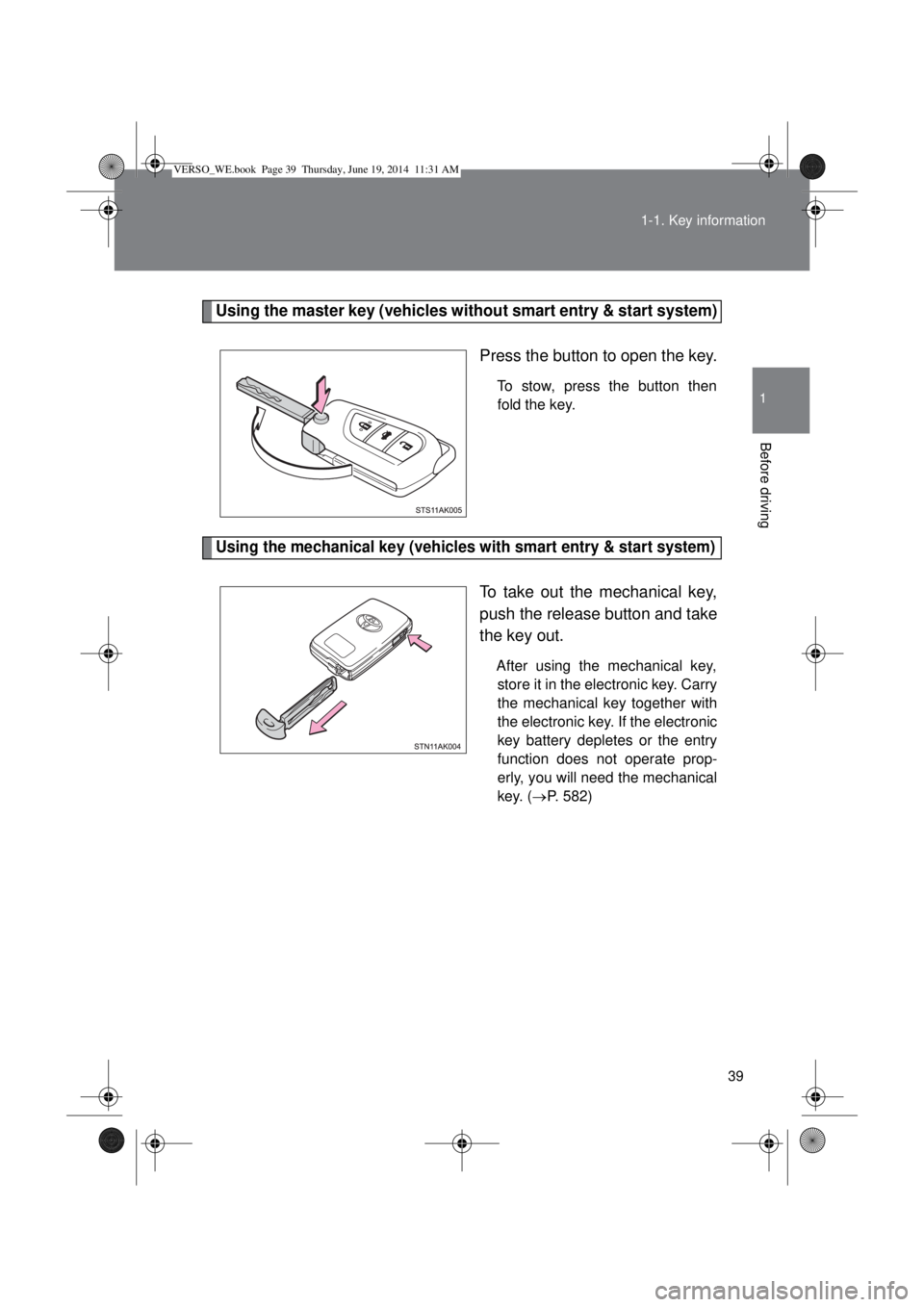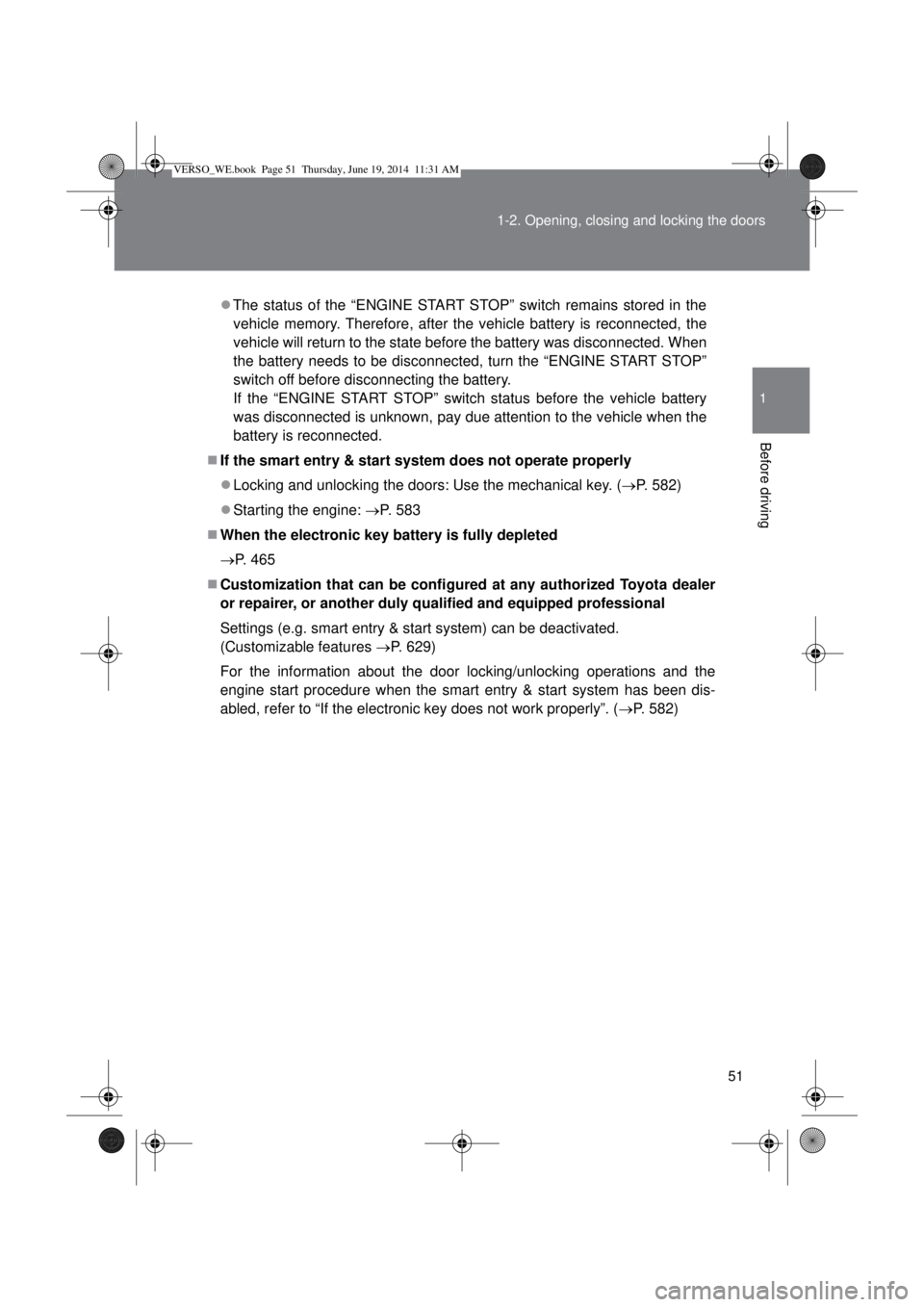2015 TOYOTA VERSO key battery
[x] Cancel search: key batteryPage 4 of 650

TABLE OF CONTENTSIndex
4
Sun visors ........................... 378
Vanity mirrors...................... 379
Conversation mirror ............ 380
Power outlets ...................... 381
Seat heaters...................... 383
Armrests............................ 385
Front seatback tables........ 386
Rear side sunshades........ 388
Assist grips ......................... 389
Floor mat............................. 390
Luggage compartment features .
392
4-1. Maintenance and care
Cleaning and protecting the ve-
hicle exterior ..................... 402
Cleaning and protecting the ve-
hicle interior ...................... 406
4-2. Maintenance
Maintenance requirements . 409
4-3. Do-it-yourself maintenance
Do-it-yourself service precau-
tions .................................. 412
Hood ................................... 416
Positioning a floor jack ........ 418
Engine compartment........... 420
Tires .................................... 443
Tire inflation pressure ......... 457
Wheels ................................ 459
Air conditioning filter ........... 462
Key battery.......................... 465Checking and replacing fuses ...
469
Light bulbs .......................... 484
5-1. Essential information
Emergency flashers ........... 502
If your vehicle needs to be towed
503
If you think something is wrong .
512
Fuel pump shut off system (gas-
oline engine)..................... 513
5-2. Steps to take in an emergency
If a warning light turns on or a
warning buzzer sounds... . 514
If a warning message is dis-
played............................... 523
If you have a flat tire (vehicles
with spare tire).................. 536
If you have a flat tire (vehicles
with emergency tire puncture
repair kit) .......................... 552
If the engine will not start ... 576
If the shift lever cannot be shifted
from “P” (vehicles with a Multid-
rive or an automatic transmis-
sion) ................................. 579
If you lose your keys .......... 580
If you cannot operate the back
door opener ...................... 581
If the electronic key does not op-
erate properly (vehicles with
smart entry & start system) .....
582
4Maintenance and care
5When trouble arises
VERSO_WE.book Page 4 Thursday, June 19, 2014 11:31 AM
Page 39 of 650

39 1-1. Key information
1
Before driving
Using the master key (vehicles without smart entry & start system)
Press the button to open the key.
To stow, press the button then
fold the key.
Using the mechanical key (vehicles with smart entry & start system)
To take out the mechanical key,
push the release button and take
the key out.
After using the mechanical key,
store it in the electronic key. Carry
the mechanical key together with
the electronic key. If the electronic
key battery depletes or the entry
function does not operate prop-
erly, you will need the mechanical
key. (P. 582)
VERSO_WE.book Page 39 Thursday, June 19, 2014 11:31 AM
Page 46 of 650

46 1-2. Opening, closing and locking the doors
Operation signals
The emergency flashers flash to indicate that the doors have been locked/
unlocked. (Locked: Once; Unlocked: Twice)
If the doors cannot be locked with the upper lock sensor of the door
handle...
Battery-saving function
The battery-saving function will be activated in order to prevent the elec-
tronic key battery and the vehicle battery from being discharged while the
vehicle is not in operation for a long time.
In the following situations, the smart entry & start system may take some
time to unlock the doors.
• The electronic key has been left in an area of approximately 2 m (6 ft.)
of the outside of the vehicle for 10 minutes or longer.
• The smart entry & start system has not been used for 5 days or longer.
If the smart entry & start system has not been used for 14 days or longer,
the doors cannot be unlocked at any doors except the driver door. In this
case, take hold of the driver door handle, or use the wireless remote con-
trol or the mechanical key, to unlock the doors.If the doors cannot be locked by touching
the lock sensor provided on the upper
edge of a door handle, simultaneously
touch the lock sensors provided on the
upper and lower edges of the door han-
dle.
VERSO_WE.book Page 46 Thursday, June 19, 2014 11:31 AM
Page 47 of 650

47 1-2. Opening, closing and locking the doors
1
Before driving
Electronic key battery depletion
The standard battery life is 1 to 2 years.
If the battery becomes low, an alarm will sound in the cabin when the
engine stops. (P. 530)
Since the electronic key receives radio waves all the time, the key battery
will be depleted even when the electronic key is not being used. If any of
the following problems occurs, it is assumed that the key battery has
been depleted. Replace it with a new battery.
• The smart entry & start system or wireless remote control does not
work
• The operating range has narrowed
• The electronic key LED light does not come on
To prevent the electronic key battery from being depleted significantly, do
not place the key within 1 m (3 ft.) of the following electrical appliances,
which produce magnetism.
• TVs
• Personal computers
• Mobile and cordless phones, and their battery chargers
• Lamps
• Induction cookers
To operate the system properly
Make sure to carry the electronic key when operating the system.
Note for electronic key operation
Do not get the electronic key too close to the vehicle when operating the
system from the outside of the vehicle. Depending on the position and
holding conditions of the electronic key, the key may not be detected cor-
rectly and the system may not operate properly. (The alarm may go off
accidentally, or the door lock prevention may not function.)
Even when the electronic key is within the effective range (detection
areas), the system may not operate properly in the following cases.
• When locking or unlocking the doors, the electronic key is too close to
a door window or door handle, near the ground, or in a high place.
• The electronic key is on the instrument panel, interior floor, or in a door
pocket, or inside the glove box.
VERSO_WE.book Page 47 Thursday, June 19, 2014 11:31 AM
Page 50 of 650

50 1-2. Opening, closing and locking the doors
Alarms and warning indicators
A combination of exterior and interior alarms as well as warnings displayed
on the multi-information display are used to prevent theft of the vehicle and
unforeseeable accidents resulting from erroneous operation. Take appropri-
ate measures in response to any warning indications on the multi-informa-
tion display. (P. 523)
The following table describes circumstances and correction procedures
when only alarms are sounded.
Note for vehicle battery disconnection and reconnection
When the doors are attempted to be unlocked by means of the smart
entry & start system just after the vehicle battery has been reconnected,
it may fail. In this case, use the wireless remote control or mechanical
key to unlock and lock the doors.
The first engine start since the last time the vehicle battery was recon-
nected may fail. The engine will start from the second attempt, so it is not
a malfunction.
AlarmSituationCorrection procedure
Exterior alarm
sounds once for 5
secondsTried to lock the vehicle
using the entry function
while a door is open.Close all of the doors
and lock the doors
again.
Interior alarm
pings continuouslyTurned the “ENGINE
START STOP” switch to
ACCESSORY mode
while the driver’s door
is open. (Opened the
driver’s door when the
“ENGINE START
STOP” switch is in
ACCESSORY mode.)Turn the “ENGINE
START STOP” switch
off and close the
driver’s door.
Turned the “ENGINE
START STOP” switch
off while the driver’s
door is open.Close the driver’s door.
VERSO_WE.book Page 50 Thursday, June 19, 2014 11:31 AM
Page 51 of 650

51 1-2. Opening, closing and locking the doors
1
Before driving
The status of the “ENGINE START STOP” switch remains stored in the
vehicle memory. Therefore, after the vehicle battery is reconnected, the
vehicle will return to the state before the battery was disconnected. When
the battery needs to be disconnected, turn the “ENGINE START STOP”
switch off before disconnecting the battery.
If the “ENGINE START STOP” switch status before the vehicle battery
was disconnected is unknown, pay due attention to the vehicle when the
battery is reconnected.
If the smart entry & start system does not operate properly
Locking and unlocking the doors: Use the mechanical key. (P. 582)
Starting the engine: P. 583
When the electronic key battery is fully depleted
P. 465
Customization that can be configured at any authorized Toyota dealer
or repairer, or another duly qualified and equipped professional
Settings (e.g. smart entry & start system) can be deactivated.
(Customizable features P. 629)
For the information about the door locking/unlocking operations and the
engine start procedure when the smart entry & start system has been dis-
abled, refer to “If the electronic key does not work properly”. (P. 582)
VERSO_WE.book Page 51 Thursday, June 19, 2014 11:31 AM
Page 63 of 650

63 1-2. Opening, closing and locking the doors
1
Before driving
NOTICE
Conditions affecting operation
The smart entry & start system uses weak radio waves. In the following situ-
ations, the communication between the electronic key and the vehicle may
be affected, preventing the smart entry & start system and wireless remote
control from operating properly. (Way of coping P. 582)
When the electronic key battery is depleted
Near a TV tower, electric power plant, gas station, radio station, large dis-
play, airport or other facility that generates strong radio waves or electrical
noise
When a portable radio, cellular phone, cordless phone or other wireless
communication device is in the vicinity
When the electronic key has come into contact with, or is covered by a
metallic object, such as the following
• Cards on which metal sheets such as foil are attached
• Cigarette boxes in which foil is used
• Metallic wallets or bags
• Coins
• Hot packs or pocket warmers
• Optical media such as CDs and DVDs
When other wireless keys that emit radio waves are used in the vicinity
When carrying the electronic key together with the following devices
• Another vehicle’s electronic key or a wireless key that emits radio
waves
• Personal computers or PDAs
• Digital audio players
• Hand-held game consoles
If window tint with a metallic content or metallic objects are attached to the
rear window
VERSO_WE.book Page 63 Thursday, June 19, 2014 11:31 AM
Page 65 of 650

65 1-2. Opening, closing and locking the doors
1
Before driving
Operation signals
The emergency flashers flash to indicate that the doors have been locked/
unlocked. (Locked: Once; Unlocked: Twice)
Door lock buzzer
If the door is not fully closed, a buzzer sounds continuously for 5 seconds if
an attempt to lock the door is made. Fully close the door to stop the buzzer,
and lock the vehicle once more.
Back door operation (vehicles without smart entry & start system)
When the back door is locked, it can be unlocked by the back door unlock
button of the wireless key. Lock the back door again when you leave the
vehicle. The back door will not lock automatically after it has been opened
and then closed.
Alarm (if equipped)
Using the wireless remote control to lock the doors will set the alarm system.
(P. 136)
Key battery depletion
Vehicles without smart entry & start system
If the wireless remote control function does not operate, the battery may
be depleted. Replace the battery when necessary. (P. 465)
Vehicles with smart entry & start system
P. 47, 465
Security feature
If a door is not opened within approximately 30 seconds after the vehicle is
unlocked, the security feature automatically locks the vehicle again.
If the wireless remote control does not operate properly
Vehicles without smart entry & start system
Locking and unlocking the doors: Use the key. (P. 73)
Vehicles with smart entry & start system
P. 582
VERSO_WE.book Page 65 Thursday, June 19, 2014 11:31 AM